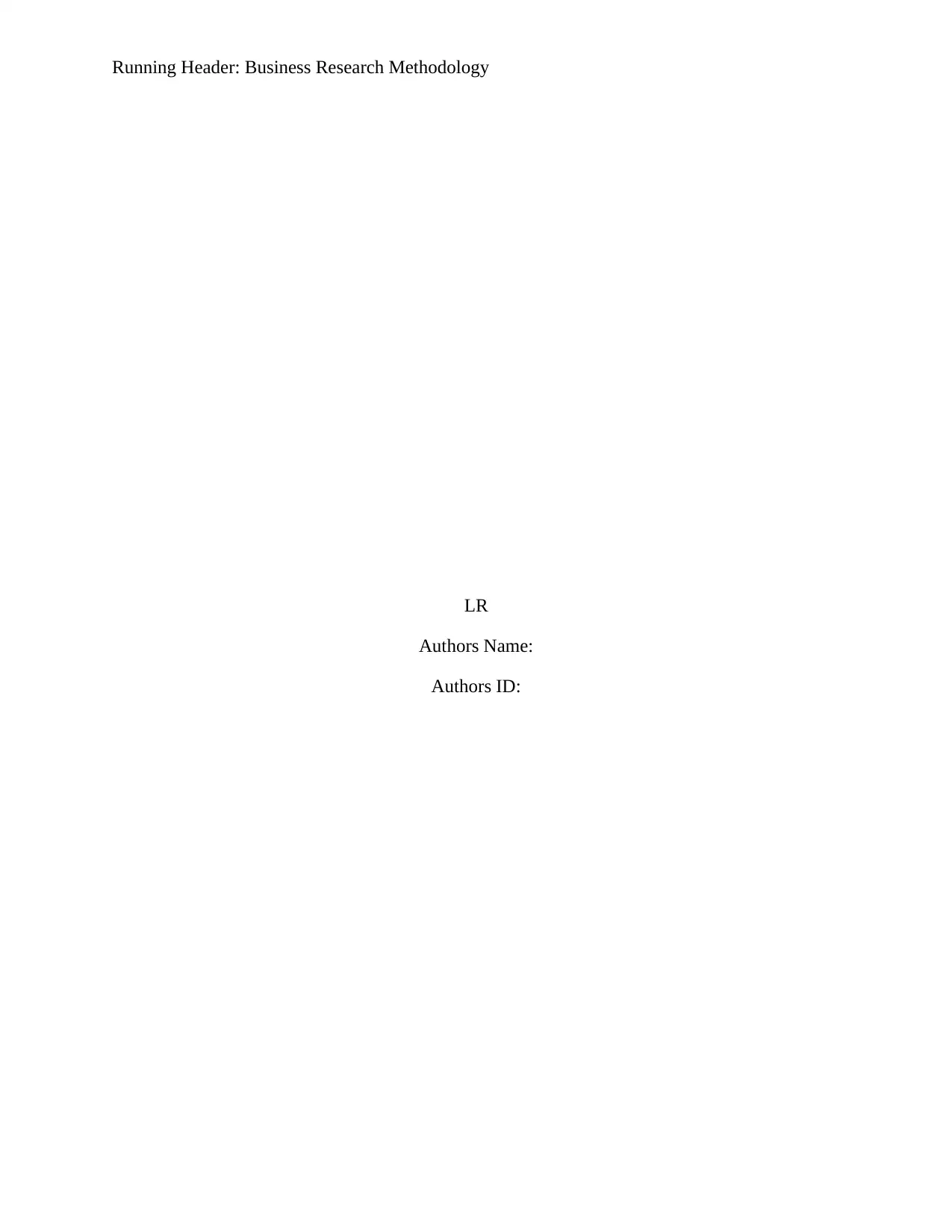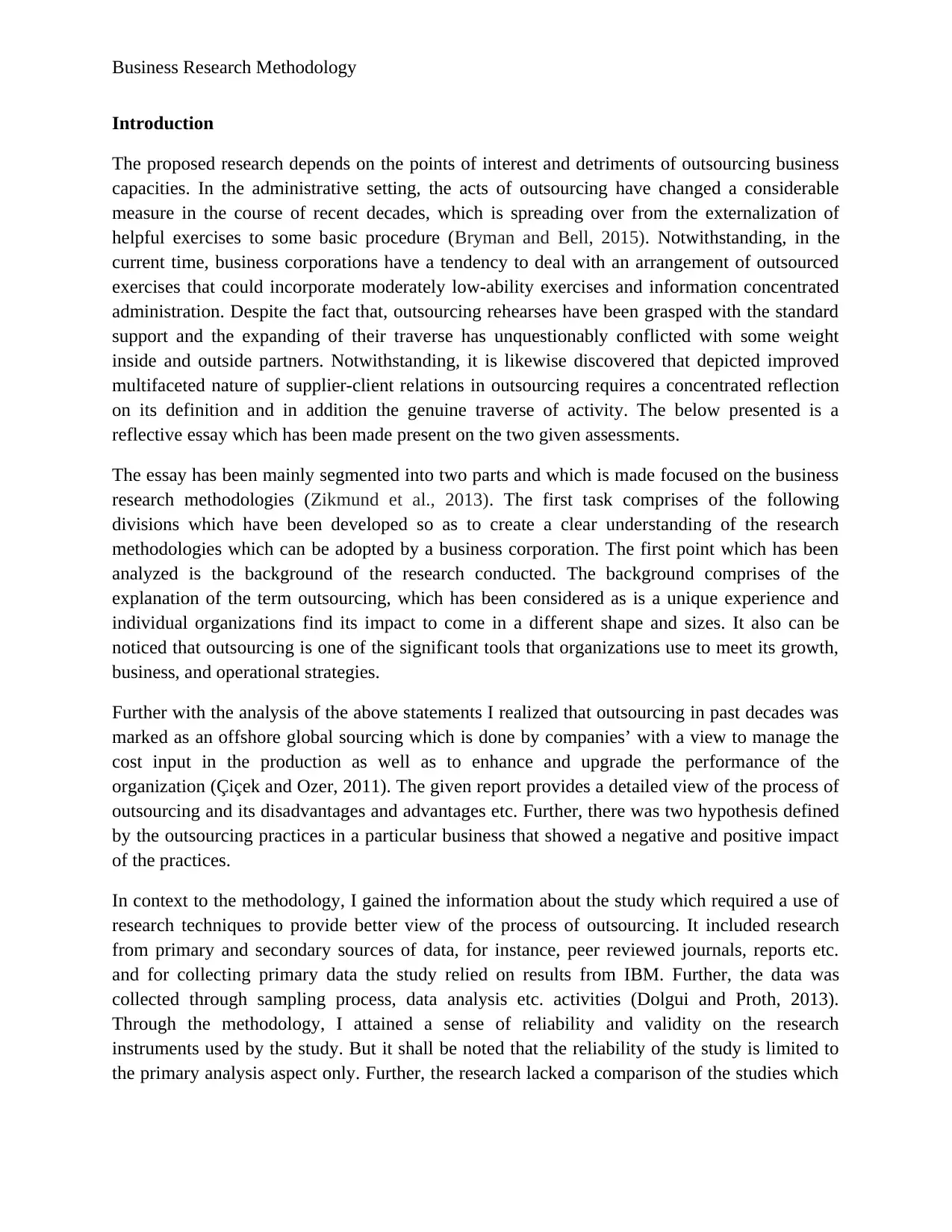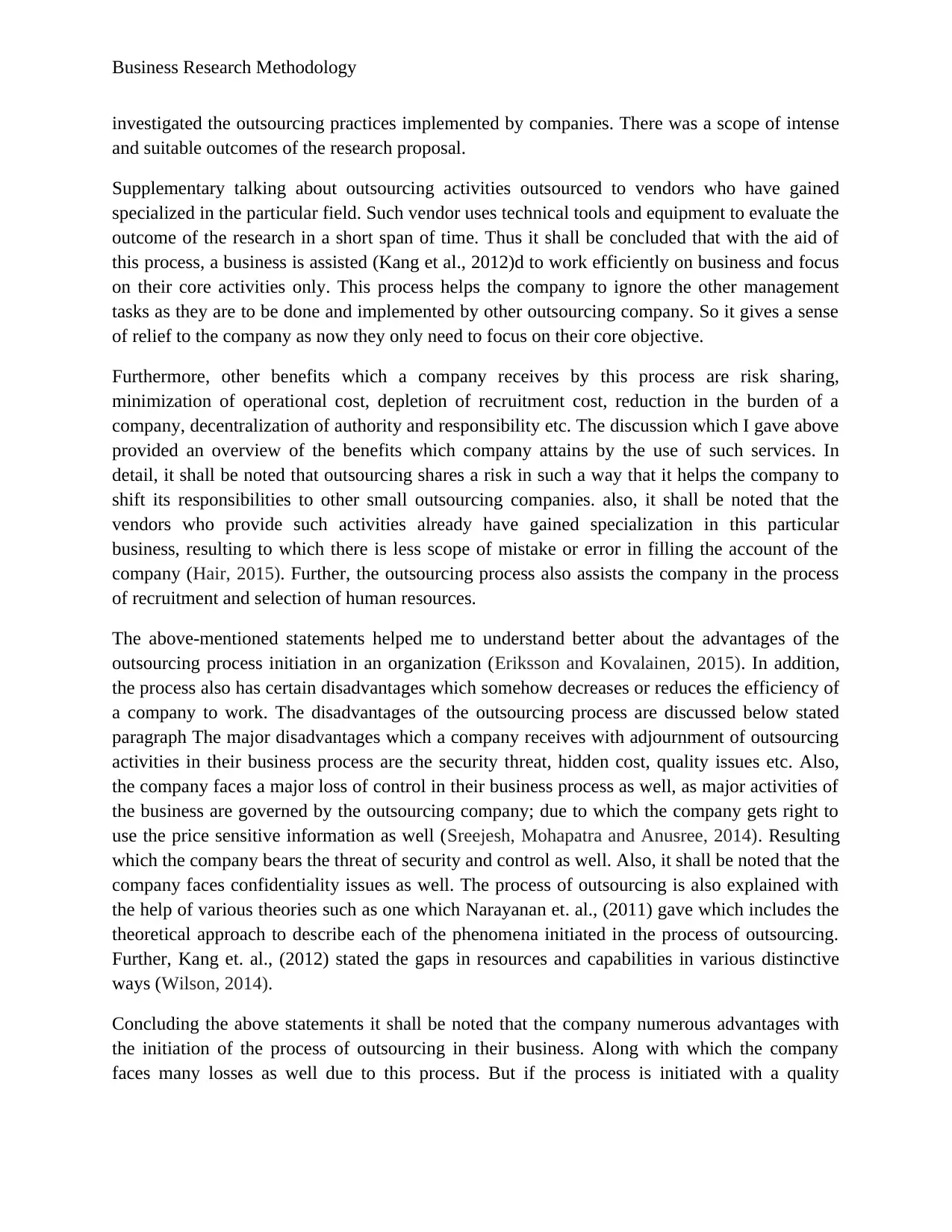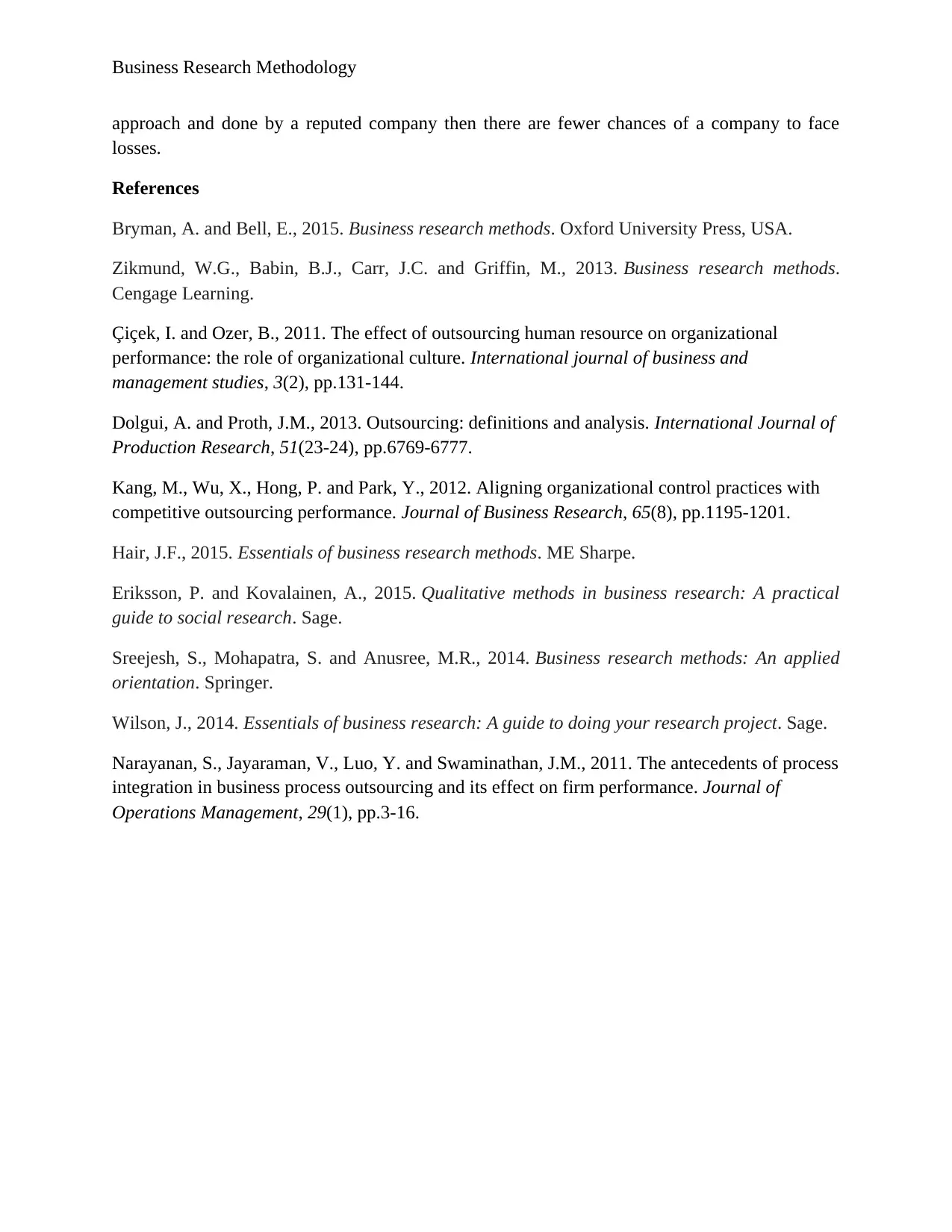Business Research: Reflective Essay on Outsourcing Methodologies
VerifiedAdded on 2020/03/02
|4
|1464
|43
Report
AI Summary
This report is a reflective essay on business research methodologies, focusing on the analysis of outsourcing practices. It begins by defining outsourcing and its evolution, highlighting its role in business growth and operational strategies. The report examines the advantages of outsourcing, such as cost reduction, risk sharing, and access to specialized expertise. It also addresses the disadvantages, including security threats and loss of control. The methodology section details the use of primary and secondary data sources, including peer-reviewed journals and reports. The report also includes a discussion of outsourcing theories and their application. Ultimately, the essay provides a comprehensive overview of the impact of outsourcing on business operations and performance, supported by relevant references and research findings.

Running Header: Business Research Methodology
LR
Authors Name:
Authors ID:
LR
Authors Name:
Authors ID:
Paraphrase This Document
Need a fresh take? Get an instant paraphrase of this document with our AI Paraphraser

Business Research Methodology
Introduction
The proposed research depends on the points of interest and detriments of outsourcing business
capacities. In the administrative setting, the acts of outsourcing have changed a considerable
measure in the course of recent decades, which is spreading over from the externalization of
helpful exercises to some basic procedure (Bryman and Bell, 2015). Notwithstanding, in the
current time, business corporations have a tendency to deal with an arrangement of outsourced
exercises that could incorporate moderately low-ability exercises and information concentrated
administration. Despite the fact that, outsourcing rehearses have been grasped with the standard
support and the expanding of their traverse has unquestionably conflicted with some weight
inside and outside partners. Notwithstanding, it is likewise discovered that depicted improved
multifaceted nature of supplier-client relations in outsourcing requires a concentrated reflection
on its definition and in addition the genuine traverse of activity. The below presented is a
reflective essay which has been made present on the two given assessments.
The essay has been mainly segmented into two parts and which is made focused on the business
research methodologies (Zikmund et al., 2013). The first task comprises of the following
divisions which have been developed so as to create a clear understanding of the research
methodologies which can be adopted by a business corporation. The first point which has been
analyzed is the background of the research conducted. The background comprises of the
explanation of the term outsourcing, which has been considered as is a unique experience and
individual organizations find its impact to come in a different shape and sizes. It also can be
noticed that outsourcing is one of the significant tools that organizations use to meet its growth,
business, and operational strategies.
Further with the analysis of the above statements I realized that outsourcing in past decades was
marked as an offshore global sourcing which is done by companies’ with a view to manage the
cost input in the production as well as to enhance and upgrade the performance of the
organization (Çiçek and Ozer, 2011). The given report provides a detailed view of the process of
outsourcing and its disadvantages and advantages etc. Further, there was two hypothesis defined
by the outsourcing practices in a particular business that showed a negative and positive impact
of the practices.
In context to the methodology, I gained the information about the study which required a use of
research techniques to provide better view of the process of outsourcing. It included research
from primary and secondary sources of data, for instance, peer reviewed journals, reports etc.
and for collecting primary data the study relied on results from IBM. Further, the data was
collected through sampling process, data analysis etc. activities (Dolgui and Proth, 2013).
Through the methodology, I attained a sense of reliability and validity on the research
instruments used by the study. But it shall be noted that the reliability of the study is limited to
the primary analysis aspect only. Further, the research lacked a comparison of the studies which
Introduction
The proposed research depends on the points of interest and detriments of outsourcing business
capacities. In the administrative setting, the acts of outsourcing have changed a considerable
measure in the course of recent decades, which is spreading over from the externalization of
helpful exercises to some basic procedure (Bryman and Bell, 2015). Notwithstanding, in the
current time, business corporations have a tendency to deal with an arrangement of outsourced
exercises that could incorporate moderately low-ability exercises and information concentrated
administration. Despite the fact that, outsourcing rehearses have been grasped with the standard
support and the expanding of their traverse has unquestionably conflicted with some weight
inside and outside partners. Notwithstanding, it is likewise discovered that depicted improved
multifaceted nature of supplier-client relations in outsourcing requires a concentrated reflection
on its definition and in addition the genuine traverse of activity. The below presented is a
reflective essay which has been made present on the two given assessments.
The essay has been mainly segmented into two parts and which is made focused on the business
research methodologies (Zikmund et al., 2013). The first task comprises of the following
divisions which have been developed so as to create a clear understanding of the research
methodologies which can be adopted by a business corporation. The first point which has been
analyzed is the background of the research conducted. The background comprises of the
explanation of the term outsourcing, which has been considered as is a unique experience and
individual organizations find its impact to come in a different shape and sizes. It also can be
noticed that outsourcing is one of the significant tools that organizations use to meet its growth,
business, and operational strategies.
Further with the analysis of the above statements I realized that outsourcing in past decades was
marked as an offshore global sourcing which is done by companies’ with a view to manage the
cost input in the production as well as to enhance and upgrade the performance of the
organization (Çiçek and Ozer, 2011). The given report provides a detailed view of the process of
outsourcing and its disadvantages and advantages etc. Further, there was two hypothesis defined
by the outsourcing practices in a particular business that showed a negative and positive impact
of the practices.
In context to the methodology, I gained the information about the study which required a use of
research techniques to provide better view of the process of outsourcing. It included research
from primary and secondary sources of data, for instance, peer reviewed journals, reports etc.
and for collecting primary data the study relied on results from IBM. Further, the data was
collected through sampling process, data analysis etc. activities (Dolgui and Proth, 2013).
Through the methodology, I attained a sense of reliability and validity on the research
instruments used by the study. But it shall be noted that the reliability of the study is limited to
the primary analysis aspect only. Further, the research lacked a comparison of the studies which

Business Research Methodology
investigated the outsourcing practices implemented by companies. There was a scope of intense
and suitable outcomes of the research proposal.
Supplementary talking about outsourcing activities outsourced to vendors who have gained
specialized in the particular field. Such vendor uses technical tools and equipment to evaluate the
outcome of the research in a short span of time. Thus it shall be concluded that with the aid of
this process, a business is assisted (Kang et al., 2012)d to work efficiently on business and focus
on their core activities only. This process helps the company to ignore the other management
tasks as they are to be done and implemented by other outsourcing company. So it gives a sense
of relief to the company as now they only need to focus on their core objective.
Furthermore, other benefits which a company receives by this process are risk sharing,
minimization of operational cost, depletion of recruitment cost, reduction in the burden of a
company, decentralization of authority and responsibility etc. The discussion which I gave above
provided an overview of the benefits which company attains by the use of such services. In
detail, it shall be noted that outsourcing shares a risk in such a way that it helps the company to
shift its responsibilities to other small outsourcing companies. also, it shall be noted that the
vendors who provide such activities already have gained specialization in this particular
business, resulting to which there is less scope of mistake or error in filling the account of the
company (Hair, 2015). Further, the outsourcing process also assists the company in the process
of recruitment and selection of human resources.
The above-mentioned statements helped me to understand better about the advantages of the
outsourcing process initiation in an organization (Eriksson and Kovalainen, 2015). In addition,
the process also has certain disadvantages which somehow decreases or reduces the efficiency of
a company to work. The disadvantages of the outsourcing process are discussed below stated
paragraph The major disadvantages which a company receives with adjournment of outsourcing
activities in their business process are the security threat, hidden cost, quality issues etc. Also,
the company faces a major loss of control in their business process as well, as major activities of
the business are governed by the outsourcing company; due to which the company gets right to
use the price sensitive information as well (Sreejesh, Mohapatra and Anusree, 2014). Resulting
which the company bears the threat of security and control as well. Also, it shall be noted that the
company faces confidentiality issues as well. The process of outsourcing is also explained with
the help of various theories such as one which Narayanan et. al., (2011) gave which includes the
theoretical approach to describe each of the phenomena initiated in the process of outsourcing.
Further, Kang et. al., (2012) stated the gaps in resources and capabilities in various distinctive
ways (Wilson, 2014).
Concluding the above statements it shall be noted that the company numerous advantages with
the initiation of the process of outsourcing in their business. Along with which the company
faces many losses as well due to this process. But if the process is initiated with a quality
investigated the outsourcing practices implemented by companies. There was a scope of intense
and suitable outcomes of the research proposal.
Supplementary talking about outsourcing activities outsourced to vendors who have gained
specialized in the particular field. Such vendor uses technical tools and equipment to evaluate the
outcome of the research in a short span of time. Thus it shall be concluded that with the aid of
this process, a business is assisted (Kang et al., 2012)d to work efficiently on business and focus
on their core activities only. This process helps the company to ignore the other management
tasks as they are to be done and implemented by other outsourcing company. So it gives a sense
of relief to the company as now they only need to focus on their core objective.
Furthermore, other benefits which a company receives by this process are risk sharing,
minimization of operational cost, depletion of recruitment cost, reduction in the burden of a
company, decentralization of authority and responsibility etc. The discussion which I gave above
provided an overview of the benefits which company attains by the use of such services. In
detail, it shall be noted that outsourcing shares a risk in such a way that it helps the company to
shift its responsibilities to other small outsourcing companies. also, it shall be noted that the
vendors who provide such activities already have gained specialization in this particular
business, resulting to which there is less scope of mistake or error in filling the account of the
company (Hair, 2015). Further, the outsourcing process also assists the company in the process
of recruitment and selection of human resources.
The above-mentioned statements helped me to understand better about the advantages of the
outsourcing process initiation in an organization (Eriksson and Kovalainen, 2015). In addition,
the process also has certain disadvantages which somehow decreases or reduces the efficiency of
a company to work. The disadvantages of the outsourcing process are discussed below stated
paragraph The major disadvantages which a company receives with adjournment of outsourcing
activities in their business process are the security threat, hidden cost, quality issues etc. Also,
the company faces a major loss of control in their business process as well, as major activities of
the business are governed by the outsourcing company; due to which the company gets right to
use the price sensitive information as well (Sreejesh, Mohapatra and Anusree, 2014). Resulting
which the company bears the threat of security and control as well. Also, it shall be noted that the
company faces confidentiality issues as well. The process of outsourcing is also explained with
the help of various theories such as one which Narayanan et. al., (2011) gave which includes the
theoretical approach to describe each of the phenomena initiated in the process of outsourcing.
Further, Kang et. al., (2012) stated the gaps in resources and capabilities in various distinctive
ways (Wilson, 2014).
Concluding the above statements it shall be noted that the company numerous advantages with
the initiation of the process of outsourcing in their business. Along with which the company
faces many losses as well due to this process. But if the process is initiated with a quality
⊘ This is a preview!⊘
Do you want full access?
Subscribe today to unlock all pages.

Trusted by 1+ million students worldwide

Business Research Methodology
approach and done by a reputed company then there are fewer chances of a company to face
losses.
References
Bryman, A. and Bell, E., 2015. Business research methods. Oxford University Press, USA.
Zikmund, W.G., Babin, B.J., Carr, J.C. and Griffin, M., 2013. Business research methods.
Cengage Learning.
Çiçek, I. and Ozer, B., 2011. The effect of outsourcing human resource on organizational
performance: the role of organizational culture. International journal of business and
management studies, 3(2), pp.131-144.
Dolgui, A. and Proth, J.M., 2013. Outsourcing: definitions and analysis. International Journal of
Production Research, 51(23-24), pp.6769-6777.
Kang, M., Wu, X., Hong, P. and Park, Y., 2012. Aligning organizational control practices with
competitive outsourcing performance. Journal of Business Research, 65(8), pp.1195-1201.
Hair, J.F., 2015. Essentials of business research methods. ME Sharpe.
Eriksson, P. and Kovalainen, A., 2015. Qualitative methods in business research: A practical
guide to social research. Sage.
Sreejesh, S., Mohapatra, S. and Anusree, M.R., 2014. Business research methods: An applied
orientation. Springer.
Wilson, J., 2014. Essentials of business research: A guide to doing your research project. Sage.
Narayanan, S., Jayaraman, V., Luo, Y. and Swaminathan, J.M., 2011. The antecedents of process
integration in business process outsourcing and its effect on firm performance. Journal of
Operations Management, 29(1), pp.3-16.
approach and done by a reputed company then there are fewer chances of a company to face
losses.
References
Bryman, A. and Bell, E., 2015. Business research methods. Oxford University Press, USA.
Zikmund, W.G., Babin, B.J., Carr, J.C. and Griffin, M., 2013. Business research methods.
Cengage Learning.
Çiçek, I. and Ozer, B., 2011. The effect of outsourcing human resource on organizational
performance: the role of organizational culture. International journal of business and
management studies, 3(2), pp.131-144.
Dolgui, A. and Proth, J.M., 2013. Outsourcing: definitions and analysis. International Journal of
Production Research, 51(23-24), pp.6769-6777.
Kang, M., Wu, X., Hong, P. and Park, Y., 2012. Aligning organizational control practices with
competitive outsourcing performance. Journal of Business Research, 65(8), pp.1195-1201.
Hair, J.F., 2015. Essentials of business research methods. ME Sharpe.
Eriksson, P. and Kovalainen, A., 2015. Qualitative methods in business research: A practical
guide to social research. Sage.
Sreejesh, S., Mohapatra, S. and Anusree, M.R., 2014. Business research methods: An applied
orientation. Springer.
Wilson, J., 2014. Essentials of business research: A guide to doing your research project. Sage.
Narayanan, S., Jayaraman, V., Luo, Y. and Swaminathan, J.M., 2011. The antecedents of process
integration in business process outsourcing and its effect on firm performance. Journal of
Operations Management, 29(1), pp.3-16.
1 out of 4
Related Documents
Your All-in-One AI-Powered Toolkit for Academic Success.
+13062052269
info@desklib.com
Available 24*7 on WhatsApp / Email
![[object Object]](/_next/static/media/star-bottom.7253800d.svg)
Unlock your academic potential
Copyright © 2020–2025 A2Z Services. All Rights Reserved. Developed and managed by ZUCOL.





